Project documentation, such as the project budget, project schedule or project plan, is critical for the successful delivery of projects. Because of that, as a project manager, you should be familiar with tools to create your project documents.
Microsoft Word is one of those tools. While it won’t help you with all the documents, charts or diagrams that you need to manage a project, it can help you create some of them. For example, you can create a Gantt chart in Word.
Why Should You Make a Gantt Chart In Word?
While Word isn’t project management software, it’s a tool that you might need to use at some point to create project reports or other types of documents. Because of this, knowing how to make a Gantt chart in Word can be helpful.
The main advantage of making a Gantt chart in Word is that it’ll help you create a project schedule that most people are familiar with, which facilitates the implementation of this project management tool in your organization, especially if you have a team that has never used Gantt charts.
However, if you need advanced project management features like identifying the critical path of your project, linking all four types of task dependencies, estimating the cost of your project or creating a project baseline to track project variance in real time, you’ll need to use Gantt chart software like ProjectManager. ProjectManager has all the project management tools and features you need to plan, schedule and track your projects from start to end including Gantt charts, kanban boards, timesheets, workload charts and much more. Get started with ProjectManager today for free.

Before we dive into the step-by-step guide on how to make a Gantt chart in Word, let’s take a quick look at an example of a Gantt chart in Word.
Example of a Gantt Chart for Word
Once you complete the steps outlined in the next section of this quick guide, you’ll have a Gantt chart just like the image below. This Gantt chart allows you to visualize your project tasks, the order in which they need to be executed, their duration and due dates over a project timeline.
The best part is that this Gantt chart for Word can adjust itself depending on the data that you feed into it. Simply rename the tasks and enter new dates and the Gantt chart template will update its bar chart based on your changes.
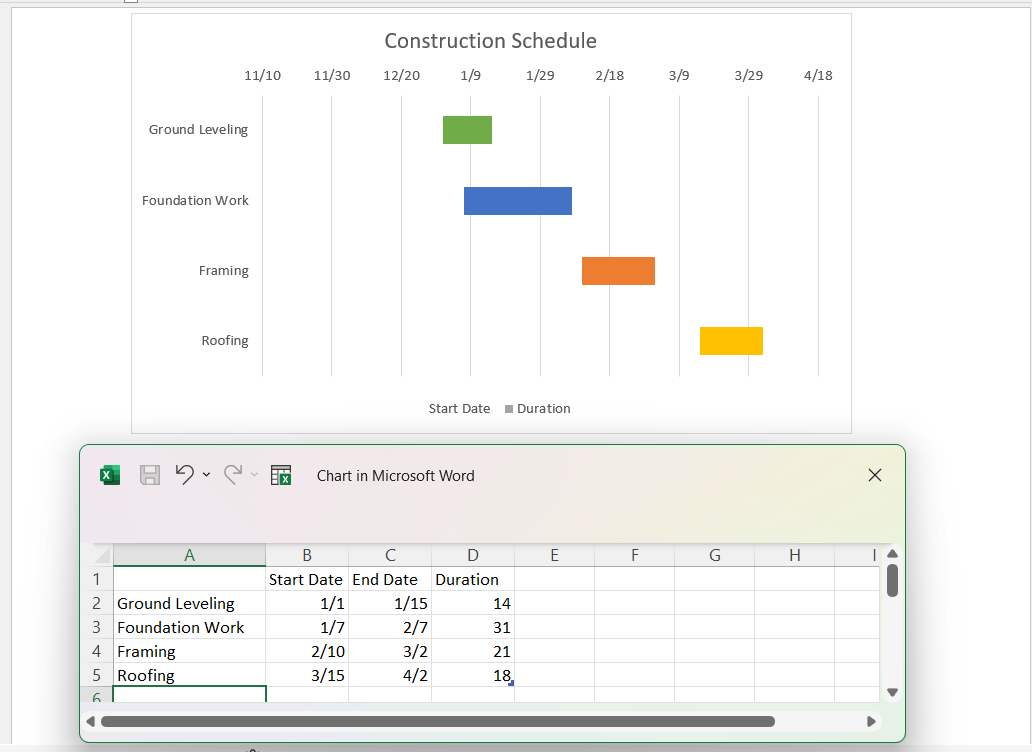
This means you can create copies of the file and use it as a template to create a schedule for any future projects your organization starts. All you’ll need to do is edit the information in the Gantt chart table shown in the image.
How to Make a Gantt Chart in Word
Now let’s learn how to make a Gantt chart in Word from scratch. The process is very similar to creating a Gantt chart in Excel or PowerPoint, so once you learn these steps you’ll also be able to easily create a Gantt chart using those tools. You can also skip these steps by downloading our free Gantt chart template for Word, the final result will be the same.
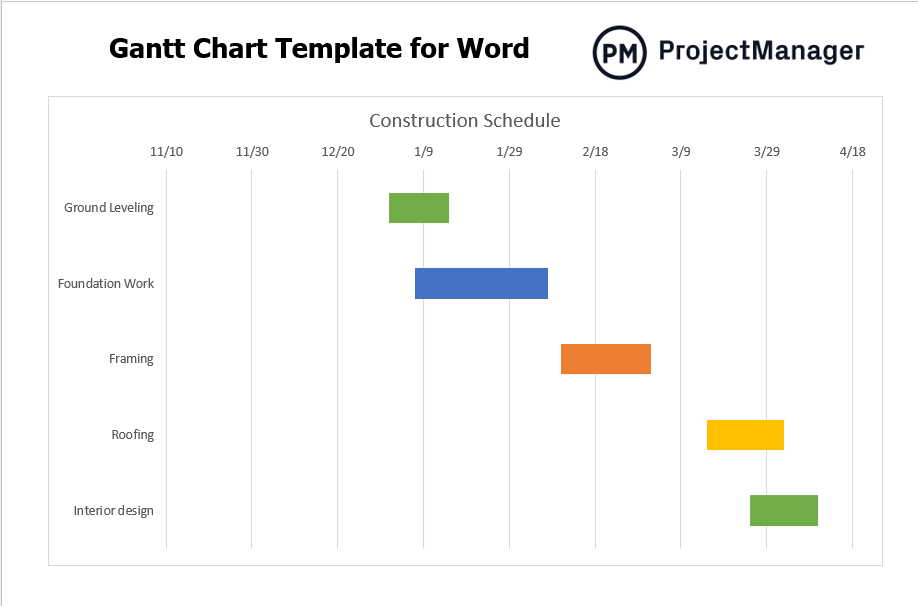
Get your free
Gantt Chart Template For Word
Use this free Gantt Chart Template For Word for Word to manage your projects better.
1. Insert a Stacked Bar Chart
Insert a stacked bar chart, which is the type of graph that’s used to create a Gantt chart. To get started, select the Insert tab at the top menu and then click “Chart.”

A window will pop up with a variety of charts and diagrams that you can insert in Microsoft Word. Select the stacked bar chart and click “OK.” A stacked bar chart with default data will appear.

2. Edit Your Gantt Chart Data
Once you insert the stacked bar chart, you’ll notice that it has two parts: a table that resembles an Excel spreadsheet and a bar chart. Now, we’ll edit the data in that table to turn this stacked bar chart into a project management chart so it shows your project task names, their due dates and duration. Let’s start by editing the text as shown in the image below. Next, we’ll edit the numeric values of this table.
Note: By default, the stacked bar chart will show your project tasks in reverse order. But don’t worry, we’ll fix this later.
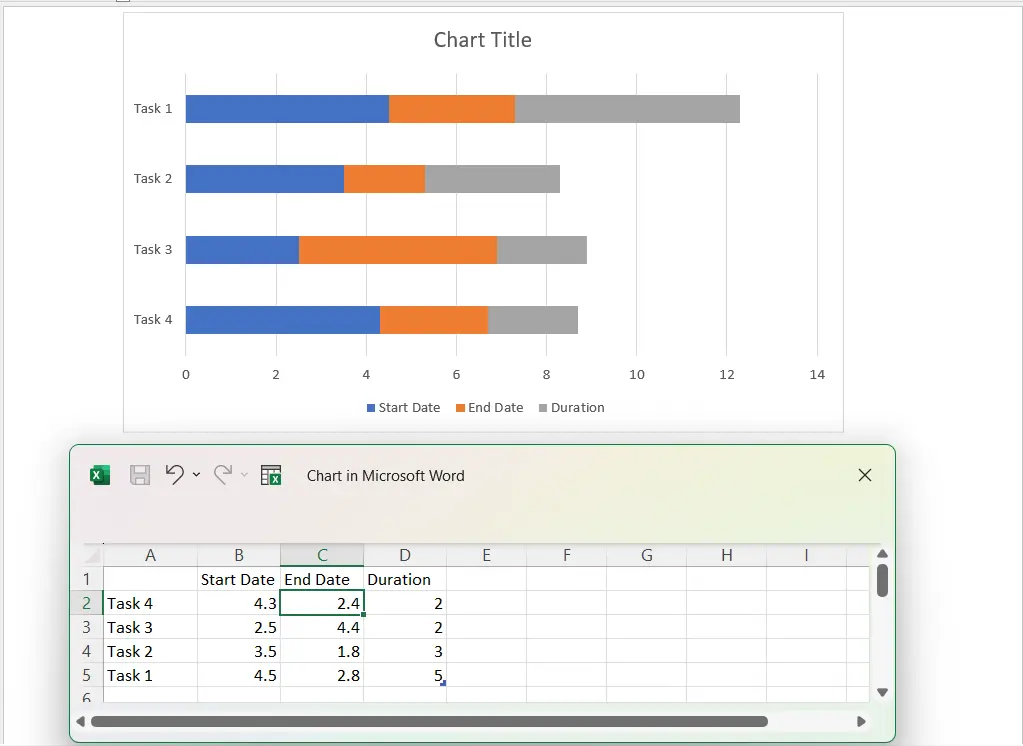
3. Format the Dates on Your Gantt Chart Timeline
To format the dates of your Gantt chart for Word, you’ll need to select the numeric values in your “Start Date” and “End Date” cells, then once you’ve selected them all, right-click them and select the “Format cells…” option from the dropdown menu.
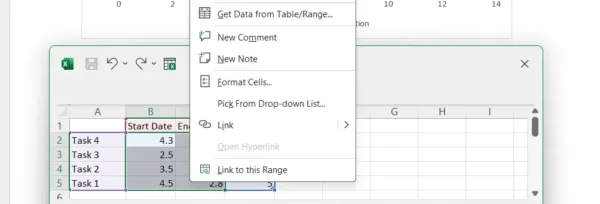
Then select the following cell format settings. Make sure that you select the right options or the Gantt chart project timeline won’t work properly. Once you’ve done so, enter the right dates for your project tasks.
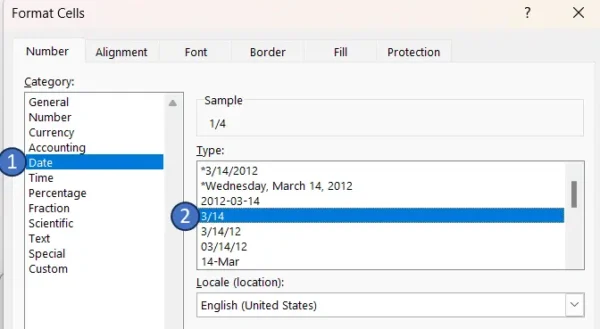
Related: Best Gantt Chart Software: Paid & Free Options Ranked
4. Add a Formula to Calculate the Duration of Your Tasks
After completing the steps above, your Gantt chart table and timeline should look like the image below. You have a list of project tasks and their due dates, but you still need to fill out the duration column. This time, we’ll use a formula that will calculate the duration of each task in days based on its due dates.
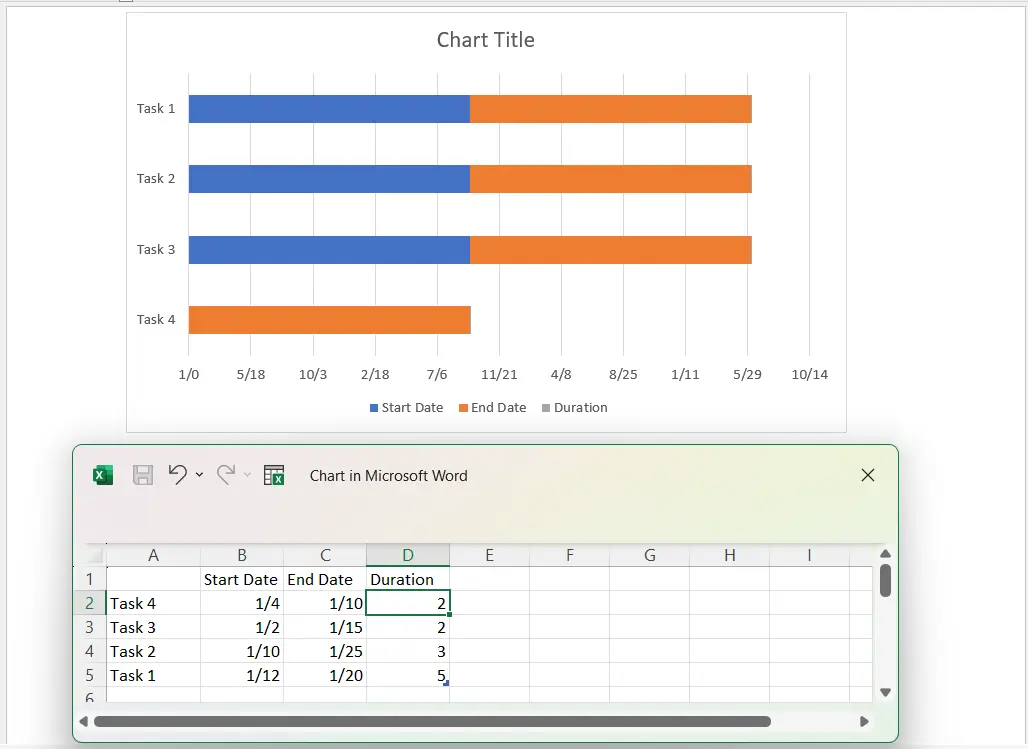
Select cell D3 and then enter the formula “=C2-B2”—you can copy and paste it from this text without the question marks.
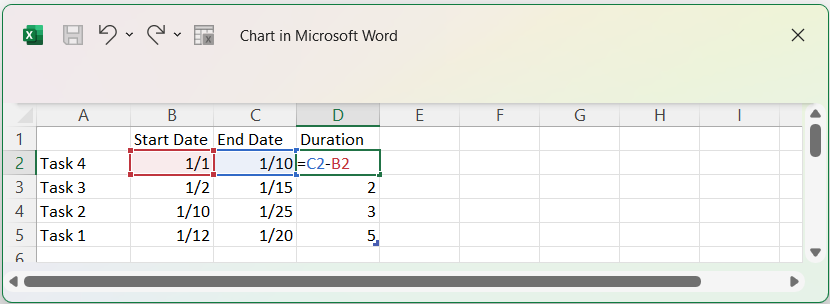
Now select cell D3 again, left-click its bottom right corner and hold the left-click button to drag the formula to all cells in column D.
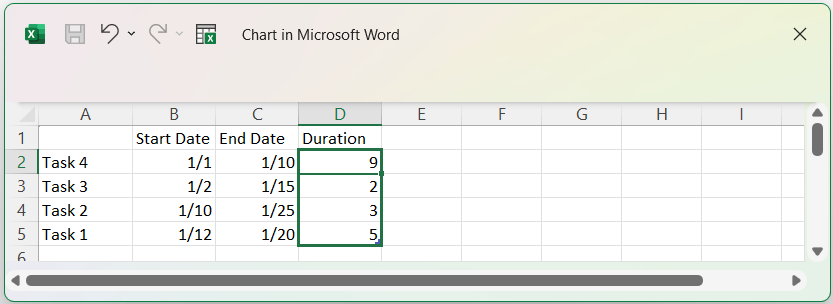
5. Turn the Stacked Bar Chart Into a Gantt Chart for Word
Now that you’re done entering all the data your Word Gantt chart needs, it’s time to format the stacked bar chart so it looks like a Gantt chart. To do so, follow the steps outlined below.
- Click the filter icon on the right side of the stacked bar chart
- Check off the “End Date” checkbox
- Click Apply
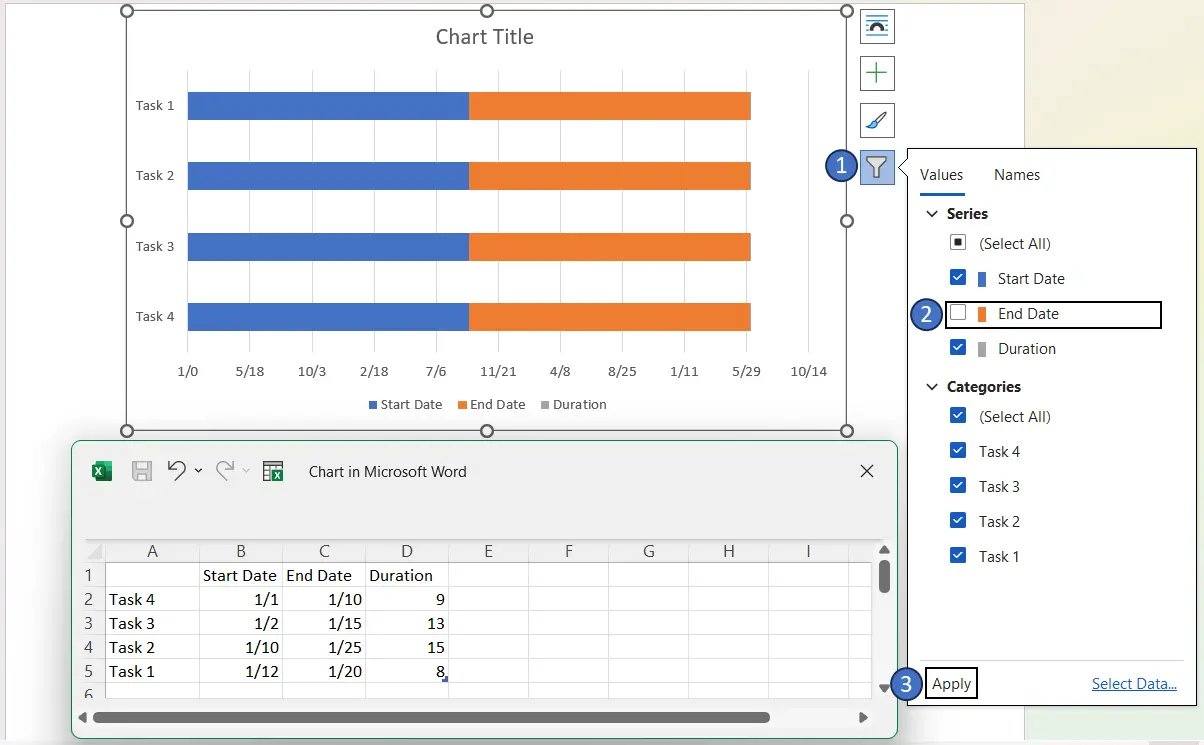
Once you’ve taken the steps above, select the blue bars and remove their fill color. The remaining bars represent each of your project tasks. As you can see, there are dates in the lower part of the chart, so you can visualize the start and end dates of your tasks. But there are still some final steps to complete before your Gantt chart for Word is ready.
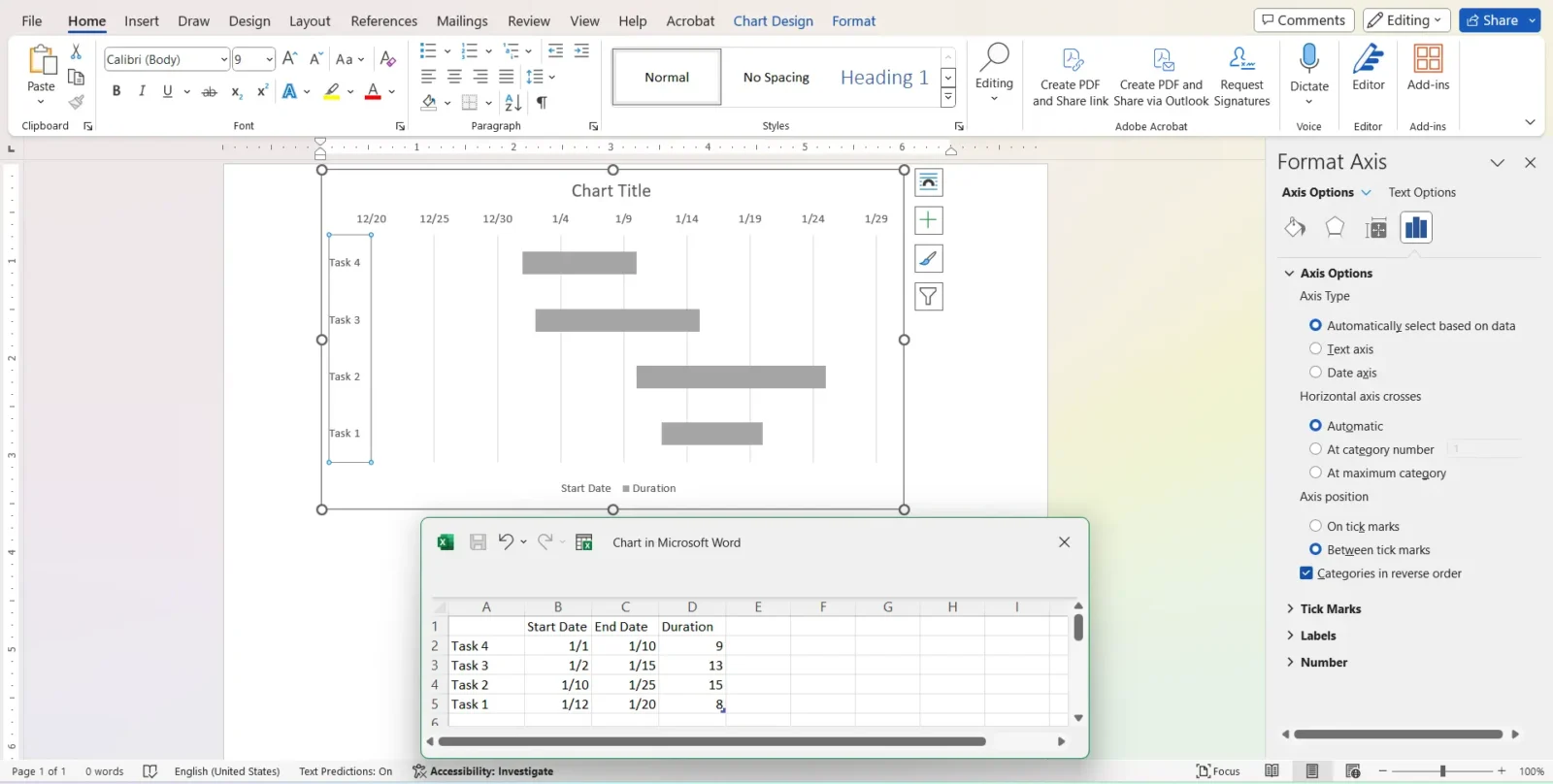
Now it’s time to configure the Gantt chart so that it shows the project tasks in the correct order. To do so, select the task names and right click them and select “Format Axis…” from the dropdown menu.
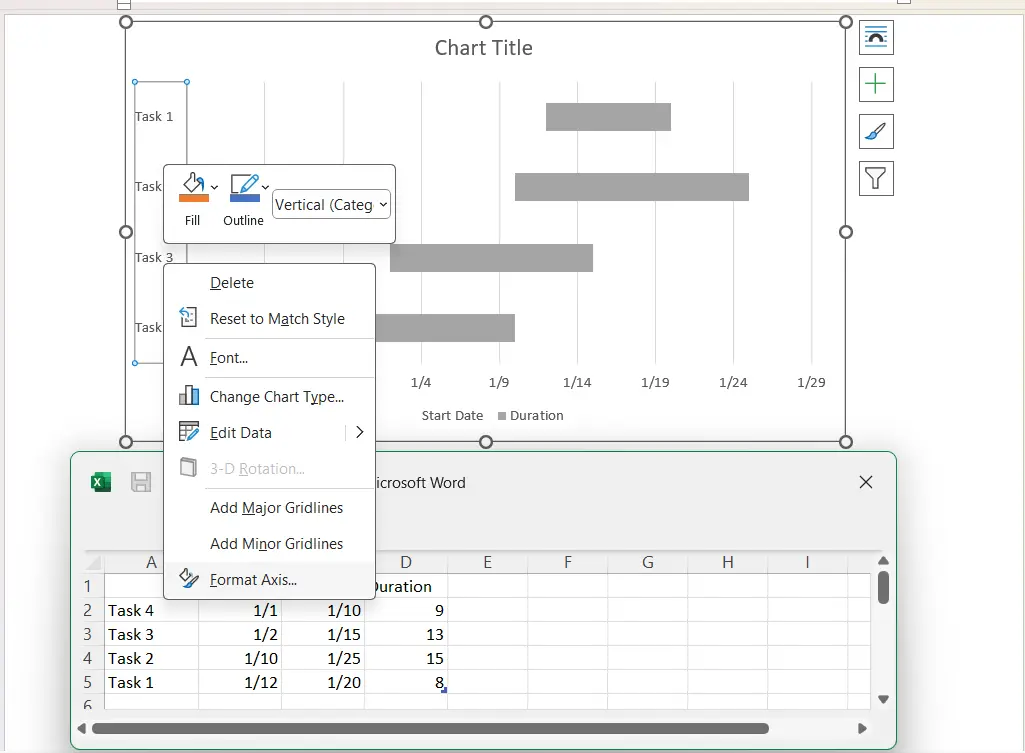
This will open the “Format Axis” panel on the right side of your screen. Now, mark the checkbox to show the categories in reverse order as shown in the image below.

Now you have a functional Gantt chart for Word that you can use to create simple project schedules that show project tasks, their due dates and duration. For example, we’ve added new task titles and dates to this Gantt chart to create a construction schedule.

Gantt Chart Word Template
If you don’t want to make a Gantt chart in Word from scratch, you can just download this free Gantt chart template for Word instead and reach the same result. This free Gantt chart template for Word will allow you to visualize your project schedule and the order in which tasks should be executed.

In addition to using the above template, you can import your Microsoft Word data directly into ProjectManager. Because ProjectManager is all online, it’s significantly easier for your team to collaborate and keep track of tasks and due dates in real time.
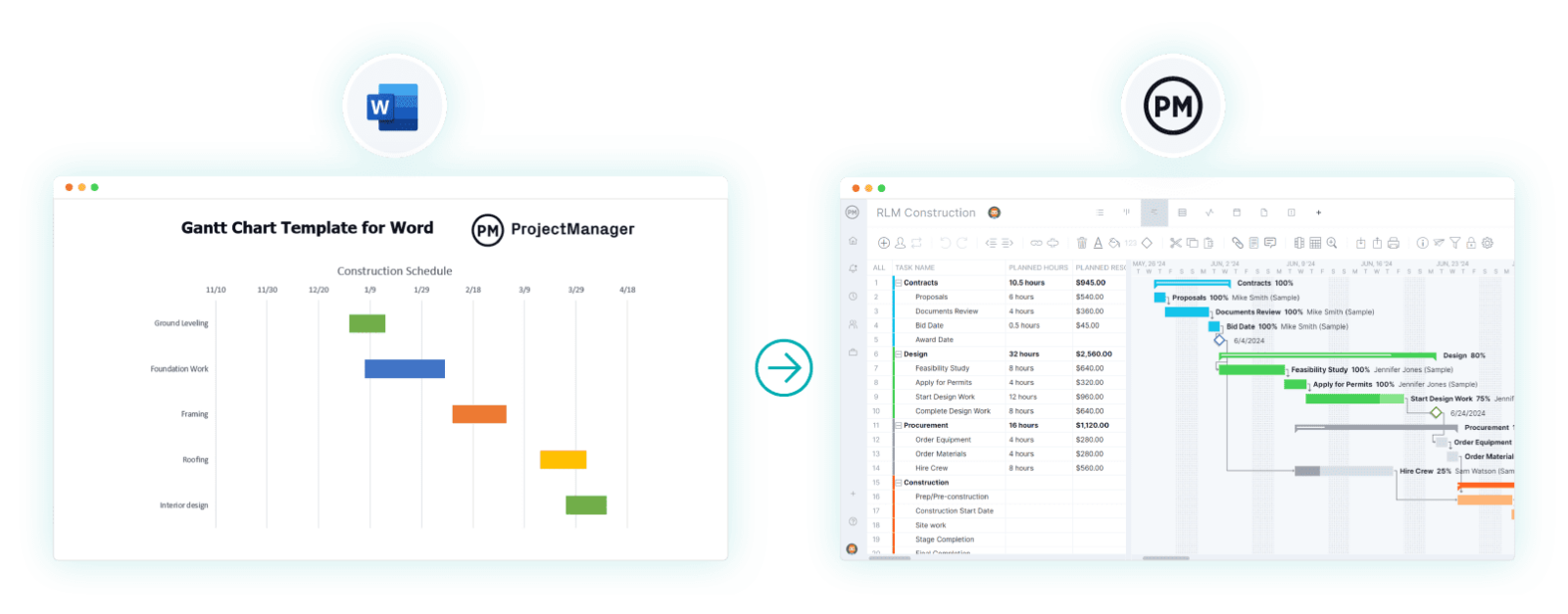
Advantages of a Gantt Chart for Word
Creating a Gantt chart in Word can be a convenient solution if you or your organization already use this software. The main advantage of using a Gantt chart for Word is that it’s a simple, readable format that can be used to share the project schedule with team members and project stakeholders.
- Once you make a Gantt chart in Word, you can append it to other Word project management documents
- The process of making a Gantt chart in Word is very similar to creating one in PowerPoint and Excel
- Because Word is such a widely used software, it’s a file format that can be shared with most project stakeholders
Disadvantages of a Gantt Chart for Word
You can make a Gantt chart in Word, but unfortunately, it will only be a visual representation of a project schedule that lacks all the features of most Gantt chart software because Word Gantt charts are not meant to be used for managing projects.
- Word Gantt charts don’t have any features to plan, schedule or track projects
- Unlike Excel Gantt chart templates, Microsoft Word files are not compatible with most Gantt chart software or project management software
- You can’t use a Gantt chart for Word to collaborate with your team
Free Related Project Management Templates for Excel and Word
We have dozens of free project management templates for Excel and Word that can help you manage each phase of your project. Here are a few of them.
Project Plan Template
This free project plan template allows you to describe some of the most important aspects of your project like its scope, schedule, budgets, risks and more. This is one of the most important project management documents there are because it sets the guidelines for the execution of the project.
Project Budget Template
In addition to your project schedule, you’ll need a project budget. This free project budget template allows you to estimate all the costs of your project and compare them against your actual project costs so you can measure whether your project is over or under budget.
Project Scope Template
Before creating a Gantt chart, you need to define the scope of your project, which refers to the work that needs to be executed to deliver a project. This project scope template helps you identify every single project task, which is necessary for creating a Gantt chart.
ProjectManager Is Better Than Making a Gantt Chart in Word
As we’ve discussed above, Microsoft Word can only help you create some project documents as it’s not a project management software. If you need a fully-featured Gantt chart to manage your projects, you should use ProjectManager instead.
Here’s a quick overview of the key features that make ProjectManager’s Gantt chart a much better project management tool than a Gantt chart for Word.
Multiple Project Management Tools
The best part of using ProjectManager Gantt charts is that you can use a wide variety of project management tools such as kanban boards, timesheets, project calendars and real-time dashboards. Any changes you make to the project schedule in the Gantt chart are automatically reflected in its other project views like task lists, kanban boards, project calendars and dashboards.
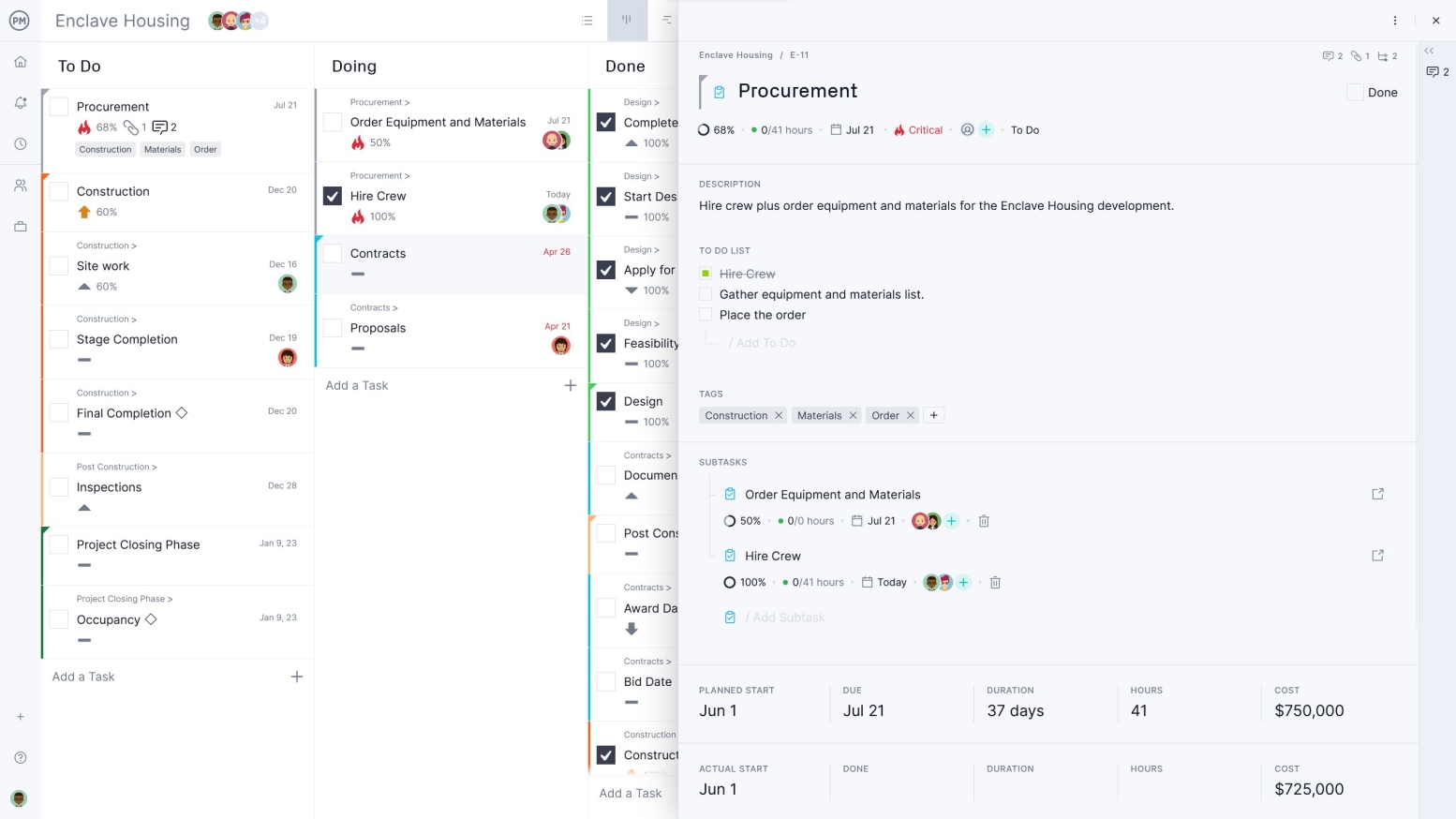
Collaborate With Your Team Online
ProjectManager is a cloud-based project management software which means it allows you to collaborate with your team online. You can create a Gantt chart and use it to assign tasks to your team members, message them and share files at the task level.
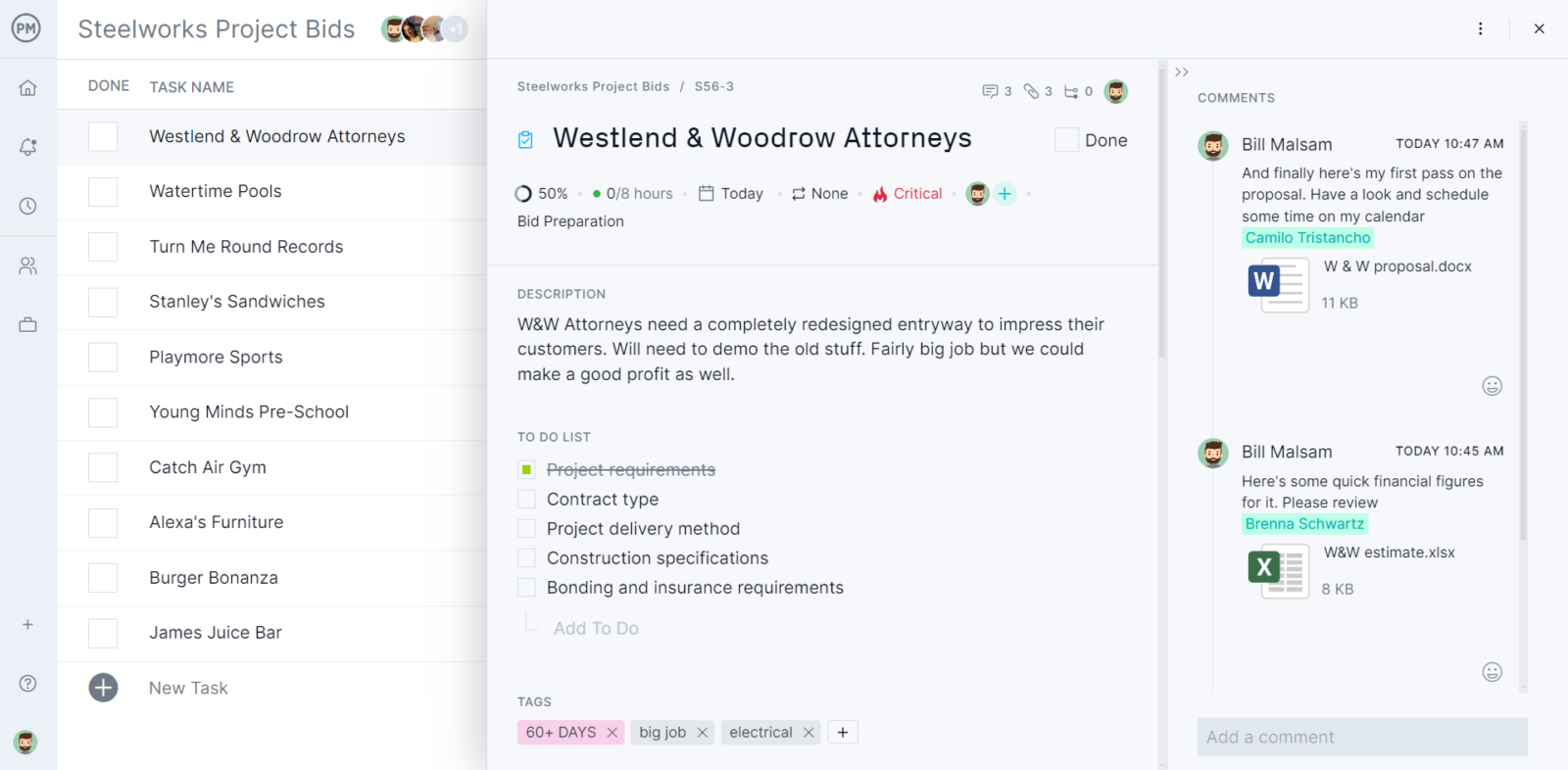
Track Resource Utilization and Project Costs
ProjectManager’s Gantt chart allows you to track the resources that are needed to complete all your project tasks, as well as their corresponding costs. Then you can use real-time dashboards to visualize the total cost of your project and your resource utilization rate.
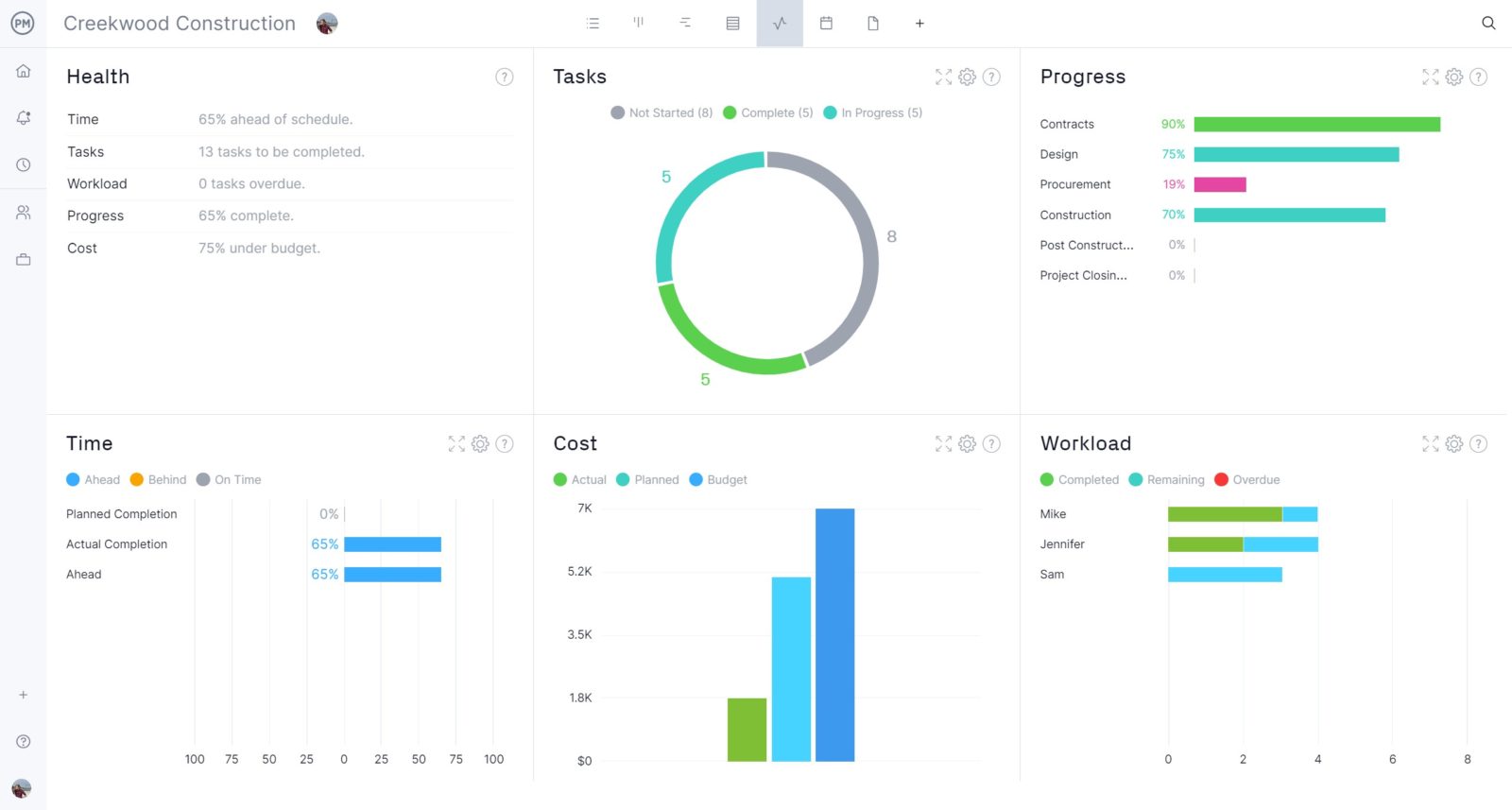
Related Gantt Chart Content
Gantt charts are one of the most important project management tools as they allow you to map out your project plan, estimate the duration of your project, create a schedule for the execution of tasks and track the progress of your team. Because of their importance for project management, we’ve created dozens of blogs, templates and guides about Gantt charts. Here are some of them.
- Free Gantt Chart Excel Template
- How to Make a Gantt Chart In Excel Step-By-Step
- How to Make a Gantt Chart in Google Docs (Template Included)
- How to Make a Gantt Chart in PowerPoint (Template Included)
- How to Make a Gantt Chart in Google Sheets (Template Included)
- Microsoft Project Gantt Chart: A How-to Guide With Pros, Cons & Alternatives
- Microsoft Planner Gantt Chart: How to Make a Gantt Chart in Microsoft Planner
ProjectManager is online project and portfolio management software that connects teams whether they’re in the office, out in the field or anywhere in between. They can share files, comment at the task level and stay updated with email and in-app notifications. Join teams at Avis, Nestle and Siemens who are using our software to deliver successful projects. Get started with ProjectManager today for free.

